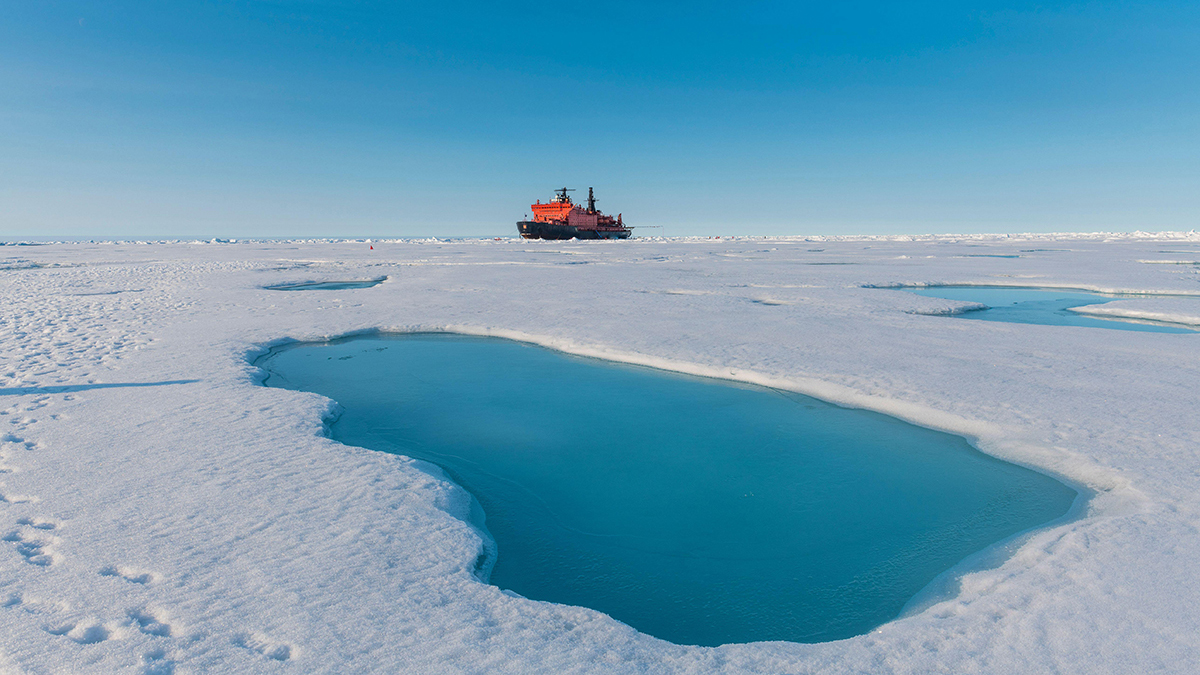Cold comfort: treaty envisaged to protect Arctic Ocean biodiversity
‘There will be irrefutable financial pressures to make a 6,000-kilometre saving between Shanghai and Rotterdam, by bisecting the high seas at the top of the planet,’ executive director of 90 North Foundation warns
Polar explorer and conservationist Pen Hadow explains why marine re/insurers and P&I clubs need to align their advisory services and business strategies, respectively, with the prevention of risks to biodiversity in the Arctic Ocean
Lloyd’s has an extraordinary opportunity to build on its heritage and shape its future reputation as the leading maritime intelligence service, according to distinguished polar explorer and conservationist Pen Hadow.
It can do this by addressing the vulnerability of the Arctic Ocean’s biodiversity to the harmful impacts associated with the new shipping routes being considered, as the region’s sea-ice cover recedes because of greenhouse gas emissions.
Hadow made history in 2003 as the first person to trek solo from Canada to the North Pole – a feat that can be compared with making the first solo ascent of Everest by the hardest route without oxygen.
The 770-km journey over 75 days, in temperatures as low as -45°C, required 30 to 40 hours of swimming between the ice floes, revealing to Hadow the scale and speed of the region’s loss of sea-ice habitat.
 Pen Hadow on his solo trek from Canada to the North Pole in 2003
Martin Hartley
Pen Hadow on his solo trek from Canada to the North Pole in 2003
Martin Hartley
After a total of 10,000 hours over 15 years on the Arctic’s sea-ice, Hadow had an epiphany that led to the creation of 90 North Foundation, which aims to establish a North Pole Marine Reserve in the form of an international treaty.
Voicing his concern shipowners are looking to exploit this newly accessible ocean, Hadow is gaining supporters from the environmental and commercial spheres. His efforts have included reaching out to delegates at last year’s Marine Insurance Norway and Cargo Insurance London conferences, and the global gathering of the International Union of Marine Insurance.
“One of the UK’s commercial assets that’s still a global centre of excellence and expertise is the specialty insurance market that is Lloyd’s. Its roots are in intelligence for shipping routes and, guess what, as the Arctic’s sea-ice cover recedes, the last shipping routes are finally being revealed,” Hadow says in an interview with Insurance Day.
“Insurers should be proactively supporting the gathering of intelligence through research programmes like those of 90 North Foundation, so they can communicate effectively the negative impacts to the shipping community of vessel activity on both the region’s vulnerable biodiversity and their own licence to operate if they’re thinking of going into the high seas of the Central Arctic Ocean,” he adds.
“The reputations of marine re/insurers, along with P&I [protection and indemnity] clubs, shipowners, ship operators and shippers, will take a severe reputational beating if they wantonly ignore the warning signs,” he continues, “because there are some very substantial organisations and international processes that are well advanced in developing an international treaty to underpin the North Pole Marine Reserve concept, and transboundary shipping, along with vessels associated with commercial fishing and deep-sea mining, are a big ‘no-no’.”
Fewer than 10 research vessels in history have ever been into the Central Arctic Ocean’s high seas “at the top” of the planet. In 2017, Hadow led the only non-icebreaking vessels ever to have sailed unobstructed by ice into the region. In two 50 ft sailboats his team penetrated nearly 300 nautical miles into the area, via the Bering Strait, while undertaking oceanographic research. This part of the world is, to date, “exceptionally undisturbed” by human activity, he says. “It’s our intention to keep it that way,” he stresses, “and it’s much simpler to keep commercial activities out by international agreement than to winkle them out once entrenched.”
Sea-ice shrinkage
The fundament to the emerging risks in the Central Arctic Ocean and wider Arctic Ocean is the receding of the sea-ice cover.
Hadow mentions a phrase he has heard used by marine insurers, “never north of 68”, which refers to a circle of latitude 68 degrees north of the Earth’s equatorial plane. According to the Lloyd’s Market Association’s joint hull committee, this concerns the limits to normal navigation – beyond which the insured needs to seek quotes for cover – although the actual degree of latitude varies around the Arctic to reflect historic winter sea-ice cover. The point of this, Hadow says, is the insurance industry gets “understandably twitchy” if its clients plan to enter areas with sea-ice cover.
The International Maritime Organization’s (IMO) definition of the Arctic Ocean reflects the 15 million square kilometre sea area historically covered by winter sea-ice, its approximate average thickness being just two to three metres. In contrast, Antarctica’s 15 million square kilometre ice sheet has an average thickness of almost 2,000 m. The decreasing area of the Arctic Ocean’s residual summer sea-ice cover is currently around 3.5 million square kilometres. Its continued seasonal shrinkage creates two substantial risks.
Hadow says: “The first is the sea-ice is not simply a geophysical surface phenomenon giving our planet’s northernmost region its characteristic white capping. It also provides a critically important reflective heat shield, which effectively keeps the northern hemisphere – and indeed the rest of the globe – a great deal cooler than it would otherwise be. But, as we continue to peel back the sea-ice cover, ever more solar energy is absorbed as heat, which then works its way through the global ocean and atmospheric circulatory systems and so the disappearance of Arctic sea-ice accelerates global warming and the associated climate changes.”
The second risk relates to the fact the sea-ice provides a physical habitat for one of Earth’s major marine ecosystems – a floating ice-reef ecosystem. And with the sea-ice cover reducing dramatically – the US National Oceanic and Atmospheric Administration estimate is 12.2% a decade over the past 40 years – it inevitably means the wildlife dependent on its existence will “already be stressed and therefore vulnerable to additional vessel-related impacts”, Hadow says.
Despite this vulnerability, the sectors known to be looking to exploit these newly accessible waters – and seabed – are commercial fishing, international shipping, hydrocarbon and mineral mining and cruise tourism.
“We first need to ensure risk managers and insurers understand the movement of vessels in marine waters absolutely is not a benign activity, but it invariably and demonstrably introduces acoustic, chemical, physical and biological impacts that result in stressors and thus potential risks to the survival and health of the indigenous biodiversity. In short, vessel activity leads to the dispersion, disruption, damage and/or destruction of marine wildlife,” Hadow adds.
Responding to the forecasted increase in vessel activity and the special operational risks posed, the IMO introduced the International Code for Ships Operating in Polar Waters (Polar Code) in 2017, which is mandatory under both the International Convention for the Safety of Life at Sea and the International Convention for the Prevention of Pollution from Ships.
The Polar Code covers the full range of design, construction, equipment, operational, training, search and rescue and environmental protection matters relevant to ships operating in the Arctic and Southern Oceans. However, in environmental terms, the Polar Code is primarily focused on the risk posed by an oil spill, which is only one of the risks vessels present to biodiversity and with a very low frequency of occurrence.
In July this year, the IMO supplemented the Polar Code by introducing its ban on the use and carriage of heavy fuel oil in the Arctic Ocean. Hadow expects this will have little immediate impact because it will allow most ships to use and carry such fuel until 2029 as there is a waiver for vessels flagged by Arctic coastal states.
Arctic Amplification effect
90 North Foundation focuses on the interface between the Arctic Ocean’s unique and vulnerable biodiversity, and the impacts that surface vessels introduce to what is the world’s fastest-changing marine environment.
Hadow says: “The Arctic Ocean has already warmed four times more than any other ocean environment, and some of its marginal sea areas, like the northern Barents Sea, in Russian and Norwegian waters, have warmed seven times faster.
“It’s not just that the ice is melting, but there are all sorts of other chemical and physical changes occurring, driven by the warming of its water column, that are affecting the habitat and therefore the indigenous species.”
A multiplicity of interconnecting feedbacks activated by the warming is known collectively as the Arctic Amplification effect.
For example, organic debris previously locked within the permafrost of the surrounding tundra is now being washed out and carried by the rivers of northern Russia into the Arctic Ocean. This relatively dark-coloured debris, held in suspension in the sea water, creates what is referred to as Arctic tea, which further increases the absorption of heat energy from the sun, thereby delaying the autumn freezing process and accelerating the spring melting processes of the sea-ice.
90 North Foundation wants to minimise the indirect human impacts within the Central Arctic Ocean – the area 200 nautical miles north of the surrounding lands with an area of 2.8 million square kilometres – and optimise the resilience of the wildlife by preventing the additional direct risks presented by vessel activity.
“This region is a global commons, a shared inheritance, to be conserved for the benefit of the global community,” Hadow stresses. “It’s the world’s most iconic marine environment featuring the animal used to symbolise climate change, the polar bear, and its disappearing sea-ice provides the biggest visible manifestation of climate change.”
There are species now being observed within the Arctic Ocean for the first time. Mackerel, for example, have been observed in the Fram Strait – the passage between Greenland and Svalbard. Another example is narwhal, normally seen around the islands of Svalbard, which have been observed about 110 km from the North Pole. Hadow contrasts these natural migrations into the waters of indigenous species – likely activated by habitat change – with the invasive biota that find themselves routinely dumped from within ship ballast waters.
“The North Pole Marine Reserve is, in effect, designed to be an Arctic Ark that will optimise the resilience of any species that finds itself there, for as long as possible, until humankind gets its act together and can manage the process of reversing global warming,” Hadow says, “which for oceans is centuries away, if not millennia, given the physics of energy and water.”
With starlight-only for up to 11 weeks straight each year, the Arctic Ocean will always have the coolest and darkest waters on the planet, which means some of the species forced to migrate there will not survive in the long term. For those that manage to, however, Hadow says the Arctic Ark will create a “last bastion of hope as a biological refugium”, with no commercial fishing, no international shipping, no mining and minimal cruise tourism.
International treaty
The envisaged North Pole Marine Reserve would be established through a treaty that combines existing international agreements, such as the Central Arctic Ocean Fisheries Agreement (CAOFA), which is a voluntary commitment against commercial fishing in the Central Arctic Ocean until 2037, along with potential IMO conservation measures for shipping, and the circumpolar nations’ historic commitment to co-operation and peaceful co-existence.
That date is etched into 90 North Foundation’s mission as the absolute deadline for a North Pole treaty. Hadow explains: “The Central Arctic Ocean is an exceptional region that we know almost nothing about in biological and ecosystem terms. Let us not, just because we can, extract the living marine resources and then accidentally find ourselves, for example, having destroyed what may prove to have been the nursery grounds for the huge north Atlantic and north Pacific fishing industry.”
The CAOFA illustrates the rare application of the precautionary principle in the face of commercial forces and at considerable geographic scale, which Hadow is urging the global commercial and diplomatic communities to expand to include transboundary shipping, deep-sea mining and cruise tourism.
Major players understand the significance of this ecosystem and the risks it faces. The UN Convention on Biological Diversity has assessed the Central Arctic Ocean to be an “ecologically or biologically significant marine area”. The UN Sustainable Goal 14 – life below water – identifies the special value of the Central Arctic Ocean. The International Union for the Conservation of Nature, a UN advisory body, is actively promoting the protection of the entire Arctic Ocean. And the Arctic Council is keeping a watching brief on how best to contribute to the custodianship of this vulnerable marine environment.
Of the 25 categories of vessel-related impacts on biodiversity, one major but under-reported impact from shipping on biodiversity is underwater radiated noise, notably from propeller cavitation. And Arctic waters, being cold, transmit sound over far greater distances than temperate or tropical waters – more than 150 km in some cases.
“If you’ve got this relentless noise emanating from a shipping route being introduced into the Arctic Ocean for the first time in human history, mammals, for example, tend to be dispersed to less favourable habitats because they can’t think straight to hunt, navigate and communicate and so it can cause a deleterious effect on the health of a population,” Hadow says.
In addition to the acoustic category, which also includes active sonar and seismic surveying, vessels can have serious chemical, biological and physical impacts. Examples of the latter include mammal strikes, when vessels accidentally ram – and thus kill or seriously injure – a whale asleep at the surface; and seabed trawling can destroy polar corals, which likely take significantly longer to recover than those of temperate waters.
 Trawling for plankton in the Central Arctic Ocean
Conor McDonnell
Trawling for plankton in the Central Arctic Ocean
Conor McDonnell
“The marine industry generally has a very poor grasp, frankly, of the dispersive, damaging or downright destructive nature of international shipping, which likes to think of itself as benign,” Hadow stresses.
The Arctic Council brokered the CAOFA, an achievement Hadow and possibly others felt worthy of a nomination for a Nobel Peace Prize, such was its success in evoking the diplomatic concept of Arctic exceptionalism and the precautionary principle with respect to sustainability. Conceivably it could build on this achievement, Hadow says, and bring about an all-encompassing treaty for the Central Arctic Ocean, if not the wider Arctic Ocean.
“The well-established but still growing phenomenon of ecological diplomacy across international boundaries has played its part in enabling agreements for the Arctic Ocean, notably through the Arctic Council, each adding a layer that is building awareness of the political case for Arctic exceptionalism,” Hadow says.
Existing agreements and emerging initiatives could be strategically “aligned and conflated” and captured in a single treaty for the Central Arctic Ocean. Also delivered in challenging times, the Antarctic Treaty System, signed in 1959 during the Cold War, offers an “encouraging parallel”, Hadow says, where the international community found a way to come together to protect a global commons.
“If the treaty ends up not using the words North Pole Marine Reserve, then so be it. The name isn’t important, but it helps us all focus on a destination,” he says. “It would be an iconic global achievement that would give the global community hope that the decision-makers responsible for managing our planet’s life-supporting ecosystems and resources understand that sustainability for humankind is not a given and they’re prepared to do the hard miles to secure it.”
Economic pressures
Hadow’s message to marine re/insurers and risk managers is there are going to be growing economic pressures to put a new shipping route “slap through” the North Pole’s high seas region. That shipping route, running from the Atlantic Ocean to the Pacific Ocean via the Central Arctic Ocean, already has a name – the Transpolar Sea Route. China has referred to this route in its state programmes as the Polar Silk Road, as part of its global Belt and Road Initiative.
Hadow highlights the geopolitical tensions that have turned the Suez Canal into a high-risk and costly bottleneck for shipping, and the possibility of climate change continuing to create a bottleneck owing to water shortages for the Panama Canal.
He says: “If these situations continue and the sea-ice opens up, then ships will look to start migrating northwards, in preference to heading via the southern Capes. There will be irrefutable financial pressures to make a 6,000-kilometre saving between Shanghai and Rotterdam, by bisecting the high seas at the top of the planet via the Fram and Bering Straits. It is the direct impacts from the vessels that threaten to turn the region’s marine biodiversity, already stressed by habitat loss, into a super-stressed state, due to the unrelenting operations of bulk, tanker and container vessels.”
Hadow is optimistic, however, that in the final analysis, flag states and shipping-related companies will support the treaty’s “overwhelming rationale” to declare the Central Arctic Ocean a marine sanctuary for wildlife in perpetuity. “Three of the world’s five largest container ship companies have already pledged never to use the Arctic Ocean, and several of the largest consumer brands have pledged similarly,” he adds.
With respect to Russia’s widely reported plans to build up transboundary shipping on the Northern Sea Route, through the waters of its exclusive economic zone to the south of the Central Arctic Ocean, Hadow believes these may be curtailed by the headwinds created by the wider international movement to avoid and protect the wider Arctic Ocean’s biodiversity. “The build-up will likely be restricted to ‘destinational movements’ with Russian vessels working Russia’s northern coast, moving raw materials and supplying coastal settlements,” he says.
The Northwest Passage, through the geographically extensive archipelago north of the Canadian mainland, is unlikely to become a major sea route because, Hadow continues, it will always be a slow and challenging route owing to its narrow and bottlenecked seaways, the possibility of sea-ice and a shallow bathymetry.
He adds: “However, in the medium term, before the Central Arctic Ocean becomes routinely ice-free for a viable seasonal duration, I’m particularly concerned about the increased number of transboundary transits from China in the past two years because this coastal marine environment is the preferred habitat for many of the Arctic’s charismatic megafauna, bowhead whale, beluga, narwhal, Atlantic walrus, polar bear and several seal species.”
Three workstreams
90 North Foundation has three workstreams. One is scientific research, for which it has a partnership with the UK’s University of Exeter – the Arctic Ocean Research Unit – and is focused on delivering evidence and insight on the interaction between biodiversity and vessels. The foundation is also commissioning UN reports through the IMO-led World Maritime University.
Its second workstream focuses on raising public awareness, understanding and engagement on the biodiversity issues posed by the Arctic’s receding sea-ice. In effect, its objective is to make the Arctic Ocean more relatable and relevant to everyone south of the circumpolar north. Projects include international research-led expeditions on the Arctic Ocean, multimedia immersive experiences in capital cities, funding a free-to-use globally accessible Arctic marine film bank, and co-producing national curriculum-related teacher resources.
Its third workstream is about providing the international leadership that will accelerate the evidence-supported conservation measures that will protect the region’s biodiversity.
Hadow says his address at IMO’s plenary session in the autumn of 2017 resulted in its secretary-general “rising to lead an ovation – a rare event”.
Despite his evident world view, Hadow’s affinity with the Arctic stems from one country in particular – Scotland. Raised on a hill farm in Perthshire, Hadow’s nanny had been under instruction to encourage him to play outside in the cold for ever-longer periods with ever-less clothing, to build his mental and physiological resilience. Enid Wigley was already familiar with polar explorers, having previously cared for – and been asked to toughen up – the only son of British Royal Navy officer and explorer, Captain Robert Falcon Scott, better known as Scott of the Antarctic, who led two famous expeditions to Antarctica. That son was Peter, who became Sir Peter Scott, founder of the World Wide Fund for Nature and the world’s first global environmental figure.
The irony of Hadow’s solo trek from Canada to the North Pole 21 years ago is the warming climate and loss of sea-ice cover means he himself will probably go down in history – not only as the first to succeed in this endeavour, but also as the last to have had the opportunity.



